When I first discovered Kinilaw na Tanigue, it quickly became my go-to appetizer for gatherings with friends and family. This Filipino-style fish ceviche transforms fresh wahoo fish into a vibrant, tangy delight that never fails to impress.
The magic happens when chunks of fresh fish "cook" in calamansi juice (or lime if you can't find calamansi), while ginger, chili, and onions infuse the dish with bold flavors that dance on your palate.
What I love most about this recipe is how simple yet impressive it is, no actual cooking required, just fresh ingredients that come together beautifully after a few hours of marinating.
This Kinilaw na Tanigue recipe delivers unforgettable flavor with minimal effort.
What is Kinilaw?
Kinilaw is the Filipino version of ceviche - a traditional method where fresh fish is "cooked" not with heat but with acid from citrus juice. This dish showcases the Philippines' abundant seafood and tropical ingredients, creating a refreshing appetizer that's popular at gatherings, especially when served with cold beer or as a pulutan (finger food) during social occasions.
Jump to:
Why You'll Love This Recipe
Fresh, zesty, and bursting with flavor, this authentic Filipino ceviche is the perfect appetizer for your next gathering. The tangy calamansi juice "cooks" the fish to perfection while the ginger and chili add a delightful kick that will leave your taste buds dancing. It's impressive yet incredibly simple to make - no actual cooking required!
Ingredients
The ingredients in this Kinilaw recipe were carefully chosen for their perfect harmony. Fresh wahoo fish provides a firm texture that holds up beautifully to the curing process. Calamansi juice delivers that signature tangy flavor that "cooks" the fish while adding brightness.
Ginger and chili bring warmth and heat that balance the acidity, while red onions add a satisfying crunch and mild sweetness. A touch of sugar helps round out the flavors, creating that perfect sweet-sour-spicy balance that makes Filipino cuisine so irresistible.
Each ingredient plays an essential role in creating an authentic Kinilaw experience that honors traditional Filipino flavors while letting the fresh fish shine.
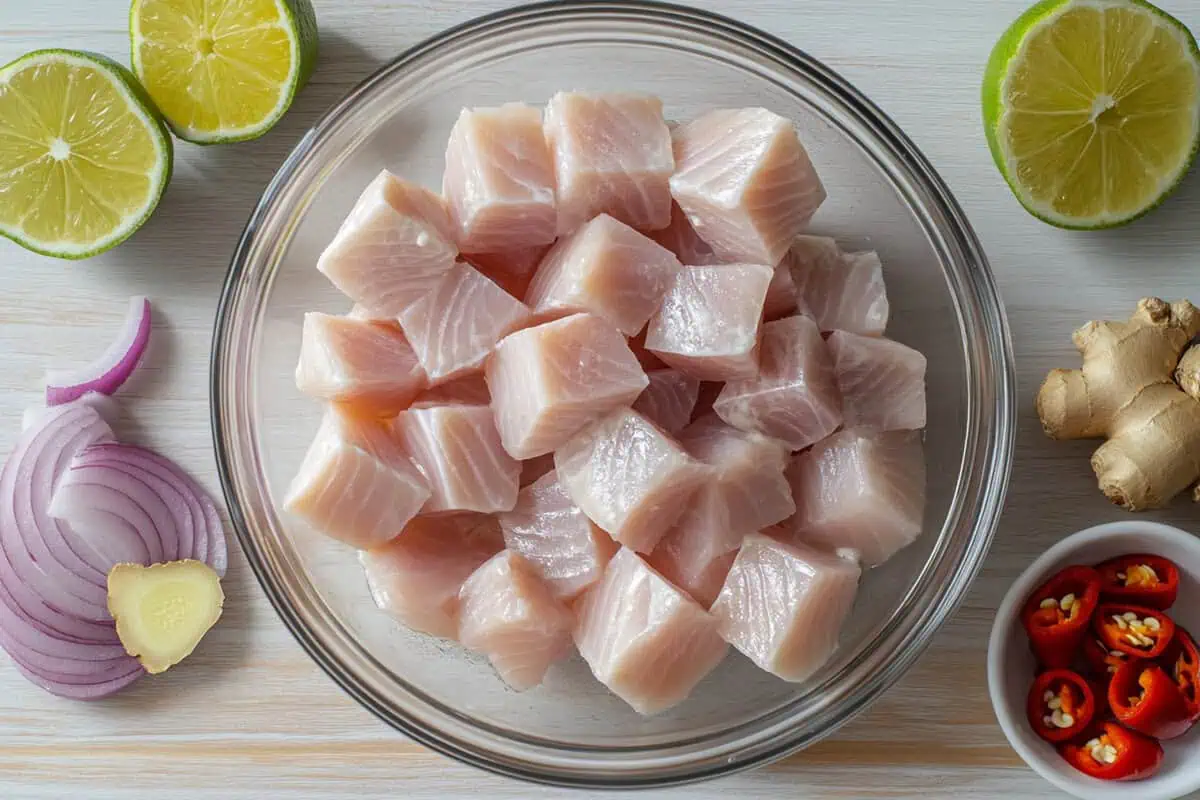
- 2 lbs. Tanigue (Wahoo fish), fillet and cut into ½-inch cubes
- 2 thumbs fresh ginger, minced
- 8 pieces hot chili (Thai chili or siling labuyo), chopped
- 15 to 20 pieces calamansi (or substitute with 8-10 limes)
- 1 medium red onion, chopped into small pieces
- ¼ teaspoon ground black pepper
- ½ teaspoon sugar
- Salt to taste
Equipment
- Large mixing bowl
- Small bowl for mixing marinade
- Sharp knife and cutting board
- Citrus juicer or reamer
- Fine mesh sieve
- Measuring spoons
- Airtight container for refrigeration
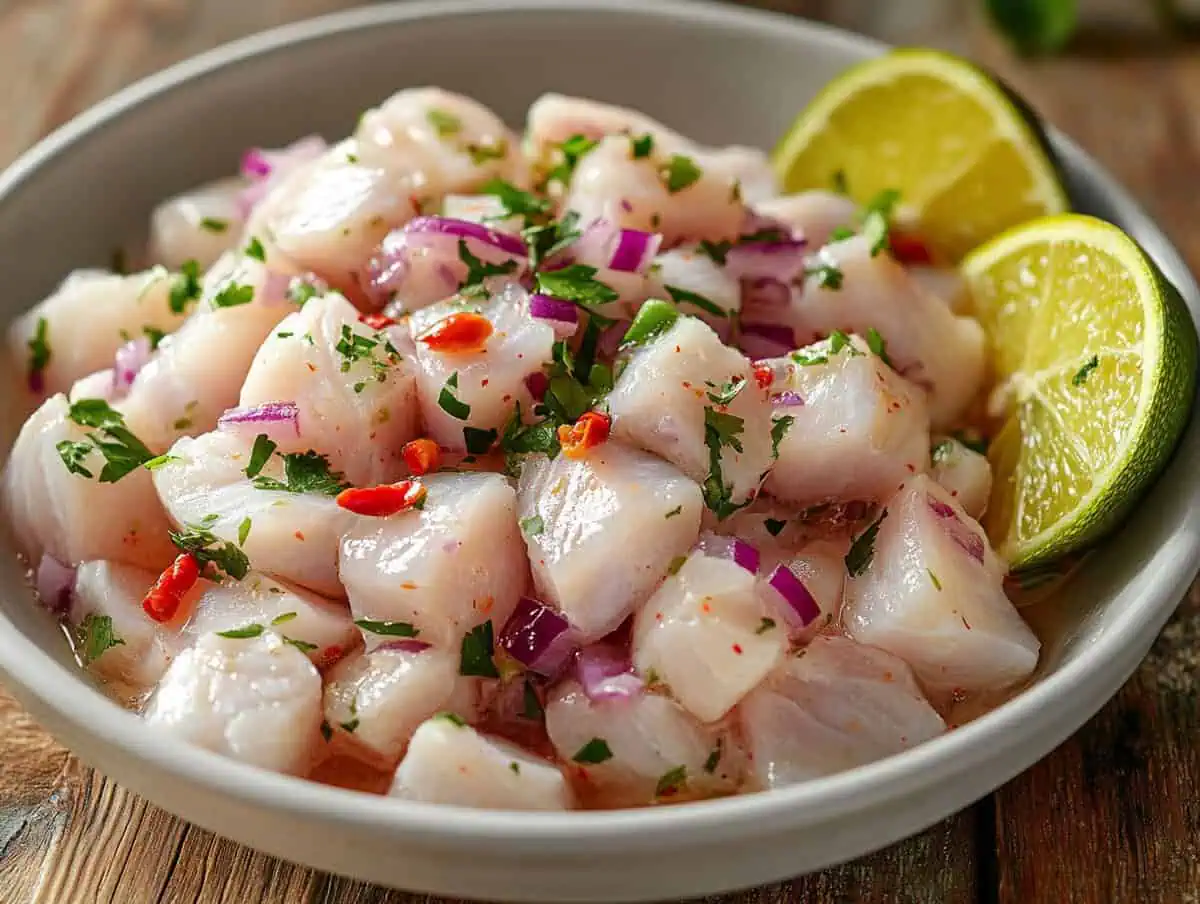
How To Make
- Prepare the marinade: Squeeze the juice from the calamansi into a large bowl, using a sieve to filter out seeds. Discard the seeds.
- Season the base: Add sugar, ½ teaspoon salt, and ground black pepper to the calamansi juice. Stir until the sugar and salt are completely dissolved.
- Add aromatics: Mix in the minced ginger, chopped chili, and diced red onion. Stir for a few seconds until all ingredients are well blended.
- Marinate the fish: Place the raw fish cubes in a separate large bowl. Pour the calamansi mixture over the fish. Gently toss until all fish pieces are well coated. Let it sit for 10 minutes at room temperature.
- Adjust flavors: Taste and adjust seasonings, adding more salt or calamansi juice if needed. Toss again to incorporate.
- Chill: Cover the bowl securely and refrigerate for at least 3 hours to properly cure the fish and allow flavors to meld.
- Serve: Present chilled in a decorative bowl as an appetizer or starter course.

Tips from Lola's Kitchen
- Freshness is crucial: Always use the freshest fish possible - this is non-negotiable for kinilaw. The fish should smell clean like the ocean with firm, translucent flesh.
- Pre-chill everything: For best results, chill your fish, bowls, and even your citrus fruits before preparation.
- Balance the acid: If the mixture is too sour, add a tiny bit more sugar to balance rather than diluting the marinade.
- Let it rest: While you can eat kinilaw after just 30 minutes of marinating, allowing it to rest for the full 3 hours develops a more complex flavor profile.
- Serve cold: Kinilaw is meant to be enjoyed cold - never at room temperature.
Substitutions
- Fish alternatives: While tanigue (wahoo) is traditional, you can use other firm white fish like mahi-mahi, tuna, or sea bass.
- Citrus options: If calamansi isn't available, use a mixture of lime and a small amount of orange juice to approximate the flavor.
- Heat level: Adjust the amount of chili based on your preference. Remove the seeds for less heat or add more chilies for extra spice.
- Add-ins: Some regions add coconut cream at the end for a creamier version, or toss in diced cucumber or tomato for added texture.
Troubleshooting
- Fish appears "overcooked": If your fish turns too white and firm, you may have marinated it too long or used too much acid. Next time, reduce the amount of citrus or the marinating time.
- Too sour: Add a bit more sugar and a pinch of salt to balance the flavors.
- Too spicy: Add more fish or a splash of coconut cream to tame the heat.
- Bitter taste: Make sure to remove all seeds from the calamansi as they can cause bitterness.
Storage & Reheating
- Storage: Kinilaw is best consumed within 24 hours of preparation. Store leftovers in an airtight container in the refrigerator.
- Not for reheating: This dish should never be heated or reheated as it will cook the fish and completely change the texture and flavor.
- Refreshing leftovers: If you must save leftovers, add a fresh squeeze of calamansi or lime juice before serving again to brighten the flavors.
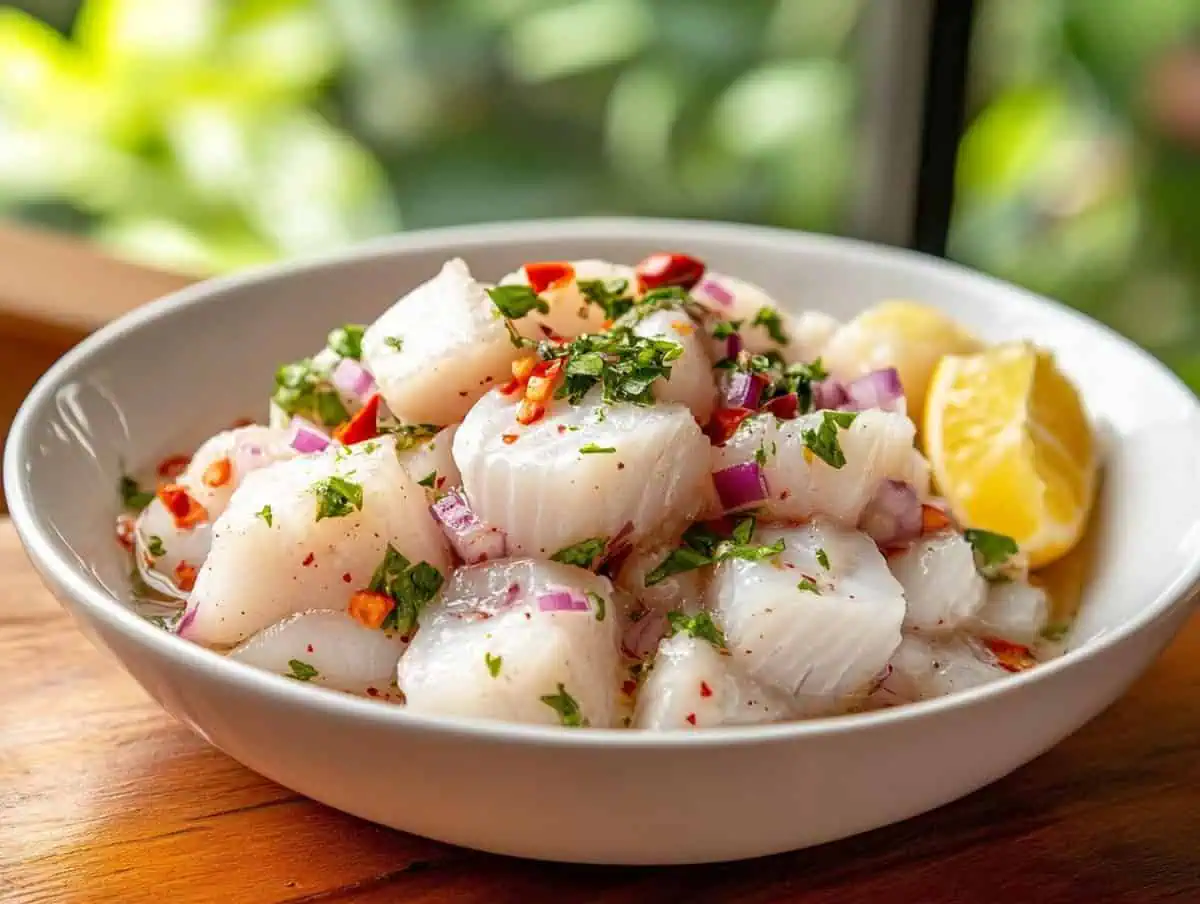
FAQ
Can I make kinilaw ahead of time?
While kinilaw can be prepared a few hours in advance, it's best consumed the same day it's made. The fish continues to "cook" in the acid, so the texture will change if left too long.
How do I know when the fish is properly cured?
The fish should become opaque and firm to the touch, but still maintain some tenderness. It shouldn't be completely white throughout or have a rubbery texture.
Is raw fish safe to eat?
Using very fresh, sushi-grade fish minimizes risks. The acid in the citrus helps kill some bacteria, but pregnant women, young children, the elderly, and those with compromised immune systems should exercise caution with any raw seafood dish.
What can I serve with kinilaw?
Kinilaw is traditionally served as an appetizer with cold beer or white wine. It also pairs well with steamed rice for a light meal, or alongside other Filipino dishes like grilled meats.
Can I use frozen fish for kinilaw?
While fresh is always best, high-quality frozen fish that has been properly thawed can work. Ensure it's completely thawed in the refrigerator and pat dry before using.
How spicy is this dish?
The spice level can be adjusted according to your preference by controlling the amount of chili peppers. Traditional versions tend to have a noticeable kick.
Related
Looking for other recipes like this? Try these:
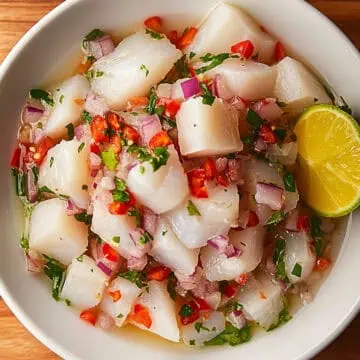
Kinilaw na Tanigue Recipe (Filipino Fish Ceviche)
Ingredients
- 2 lbs. Tanigue Wahoo fish, fillet and cut into ½-inch cubes
- 2 thumbs fresh ginger minced
- 8 pieces hot chili Thai chili or siling labuyo, chopped
- 15 to 20 pieces calamansi or substitute with 8-10 limes
- 1 medium red onion chopped into small pieces
- ¼ teaspoon ground black pepper
- ½ teaspoon sugar
- Salt to taste
Instructions
- Prepare the marinade: Squeeze the juice from the calamansi into a large bowl, using a sieve to filter out seeds. Discard the seeds.
- Season the base: Add sugar, ½ teaspoon salt, and ground black pepper to the calamansi juice. Stir until the sugar and salt are completely dissolved.
- Add aromatics: Mix in the minced ginger, chopped chili, and diced red onion. Stir for a few seconds until all ingredients are well blended.
- Marinate the fish: Place the raw fish cubes in a separate large bowl. Pour the calamansi mixture over the fish. Gently toss until all fish pieces are well coated. Let it sit for 10 minutes at room temperature.
- Adjust flavors: Taste and adjust seasonings, adding more salt or calamansi juice if needed. Toss again to incorporate.
- Chill: Cover the bowl securely and refrigerate for at least 3 hours to properly cure the fish and allow flavors to meld.
- Serve: Present chilled in a decorative bowl as an appetizer or starter course.
Tips from Lola's Kitchen
- Freshness is crucial: Always use the freshest fish possible - this is non-negotiable for kinilaw. The fish should smell clean like the ocean with firm, translucent flesh.
- Pre-chill everything: For best results, chill your fish, bowls, and even your citrus fruits before preparation.
- Balance the acid: If the mixture is too sour, add a tiny bit more sugar to balance rather than diluting the marinade.
- Let it rest: While you can eat kinilaw after just 30 minutes of marinating, allowing it to rest for the full 3 hours develops a more complex flavor profile.
- Serve cold: Kinilaw is meant to be enjoyed cold - never at room temperature.
The Story Behind Kinilaw na Tanigue
Kinilaw na Tanigue has deep roots in Filipino culinary history, dating back centuries before Western influence reached the Philippine archipelago. This traditional Filipino fish ceviche showcases the ingenuity of coastal communities who developed methods to prepare and preserve fresh seafood without cooking. The word "kinilaw" comes from "kilaw," which means "eaten fresh" in several Filipino dialects, highlighting the dish's essence of freshness and simplicity.
As an island nation surrounded by abundant waters, the Philippines has always had a special relationship with seafood. Kinilaw emerged as a practical way for fishermen to enjoy their catch immediately, using readily available local ingredients like calamansi, a native citrus fruit that grows abundantly throughout the country. This preparation method allowed fishing communities to enjoy fresh fish at its peak flavor, particularly important in tropical climates before modern refrigeration.
What makes Filipino kinilaw distinct from other ceviche variations found across Latin America is its unique use of ginger and sometimes coconut milk. These ingredients reflect the Southeast Asian influences that shape Filipino cuisine, creating a flavor profile that's simultaneously tangy, spicy, and subtly sweet. Regional variations exist throughout the Philippines, with some areas adding coconut cream for richness, while others incorporate local fruits like green mangoes or star apples.
Beyond its delicious taste, kinilaw holds cultural significance as a dish commonly served during celebrations and gatherings. It's particularly popular during beach outings and fiestas, where it's often enjoyed as "pulutan" – finger food served alongside alcoholic beverages. The communal nature of sharing kinilaw represents the Filipino value of "pakikisama" or togetherness, making this dish not just a culinary delight but also a symbol of Filipino hospitality.
Today, kinilaw continues to evolve while maintaining its authentic roots. Modern Filipino chefs both at home and abroad are experimenting with different types of seafood and additional ingredients, but the fundamentals remain unchanged – the freshest fish, native citrus, and a perfect balance of aromatics. Whether you're enjoying it on a tropical beach in the Philippines or preparing it in your own kitchen, Kinilaw na Tanigue offers a genuine taste of Filipino coastal cuisine that has stood the test of time.
For those seeking authentic Filipino flavors, mastering this traditional kinilaw recipe provides a direct connection to generations of culinary wisdom from the Pearl of the Orient Seas. The simple yet sophisticated technique of "cooking" fish in acid remains as relevant today as it was centuries ago, proving that sometimes the most enduring culinary treasures are also the simplest.
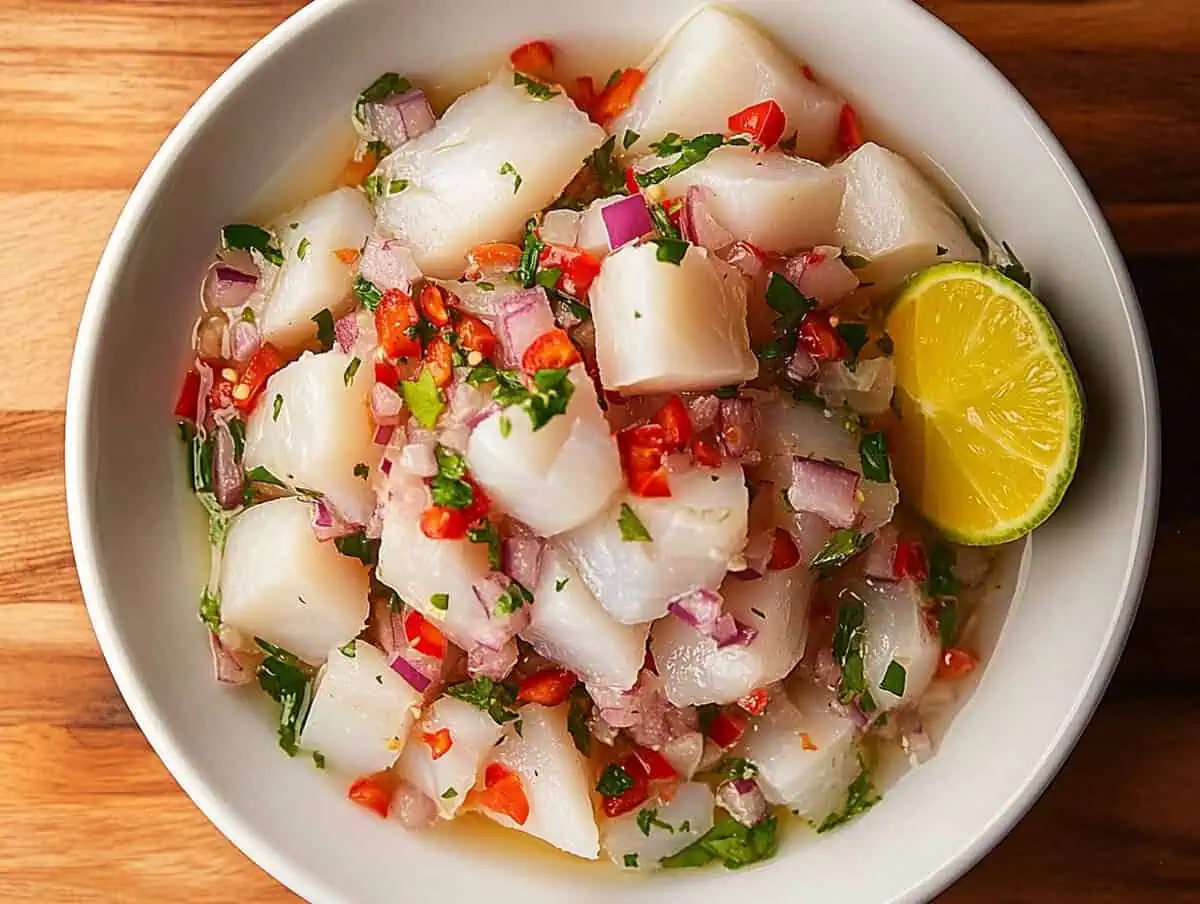









Comments
No Comments